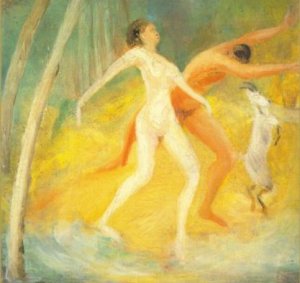‘L’écriture féminine est une écriture du Dedans : l’intérieur du corps, l’intérieur de la maison’; this is a statement which very well exemplifies Didier’s thoughts on female writing in her book L’écriture-femme, a brief but very interesting selection of female writers since the Middle Ages to the 20th century. The book is lovely written and very reccomendable for its analysis of the works of a few authors. Didier approaches her analysis from that which makes singular a female writing in contrast to a male writing; in this context, she outlines writing and text characteristics usually belonging to women writers – she repeatedly warns against dangerous generalizations but insists on a set of particular details usually found in female writings. At the end of the book she calls for a mutual enrichment between male and female authors learning from what they can teach to each other being her critique directed towards the historical Western general exclusion of female approaches to the text and over-valorization of what is masculine. For female writers to be awarded there is no need to write like men but to accept how – and what – they write.
Historically, being women more confined to their domestic spaces, they wrote about what was inside the house, about topics talked mostly among women, and issues they were concerned about, and they have done it differently than men. Yet in the 20th C. there are big differences between Virginia Woolf and Ford Madox Ford being they both recognized Modernist and cultivated writers. Henry James and Edith Wharton are another example of fellow contemporaries who read each other, and still an attentive reader can draw a line from Jane Austen to Emily Brontë finishing in Wharton, so different from James’s narrative, style and approach to reality. Didier, Cixous did, relates female writing to the female body, but also to women’s relationship with the house and maternity: ‘Le désir d’écrire, aussi fondamental peut-être que le désir d’enfanter et qui probablement répond à la même pulsion, ne pouvait être utilisé de la même façon par la société. Si l’enfantement apparaissait comme la condition même de la survie de tout groupe humain et par conséquent devait être organisé dans une structure sociale, le désir d’écrire, lui, semblait au contraire marginal, subversif, à tout le moins inutile’. Therefore, creation and pro-creation going hand by hand, and indeed, it is not till Modernism that most women wrote and wrote subversive literature. According to Didier, psychoanalysis may have pushed these women to write due to its assertion that differences on identities were important: ‘La véritable conquête de l’écriture féminine moderne aura été peut-être, aidée là encore par tout un courant de pensée issu à la foi de la psychanalyse et de l’existensialisme, d’inscrire différemment l’identité dans le texte’.
Some of the characteristics Didier attributes to female writing are its orality: being women the ones who repeated tales inside the house, they transmitted oral particularities to the written text: ‘une écriture telle que le flux de la parole s’y retrouve, avec ses soubresauts, ses ruptures et ses cris’. Another characteristic is the temporal perception strongly marked by women’s biological cycles: ‘Il est possible aussi que la femme ressente le temps autrement que ne le fait l’homme, puisque son rythme biologique est spécifique. Temps cyclique, toujours recommencé, mais, avec ses ruptures, sa monotonie et ses discontinuités’. And finally the body makes another big difference: ‘‘La présence de la personne et du sujet impose immanquablement la présence du corps dans le texte. Et il est bien évident que c’est peut-être le seul point sur lequel la spécificité soit absolument incontestable, absolue. Si l’écriture féminine apparaît comme neuve et révolutionnaire, c’est dans la mesure où elle est écriture du corps féminin’.
The body is undeniable, and marks a very visible difference and one may say it makes physical the two previous points: voice and biological temporality. But the female also feels different from the male one, and experiences sexuality in another way – being of course, at the same time, different for every single person – so that it may affect the writing. It explains again the boom of female writers, so to say, after Freud, writing not only in a very particular way but of their bodies: the female body, so under control during the 19th C., is put into paper by women- men did it before – at the turn of the century: ‘Monde de sensations jusque-là inexplorées et qui supposeraient, pour etre exprimées, une autre langue’.











